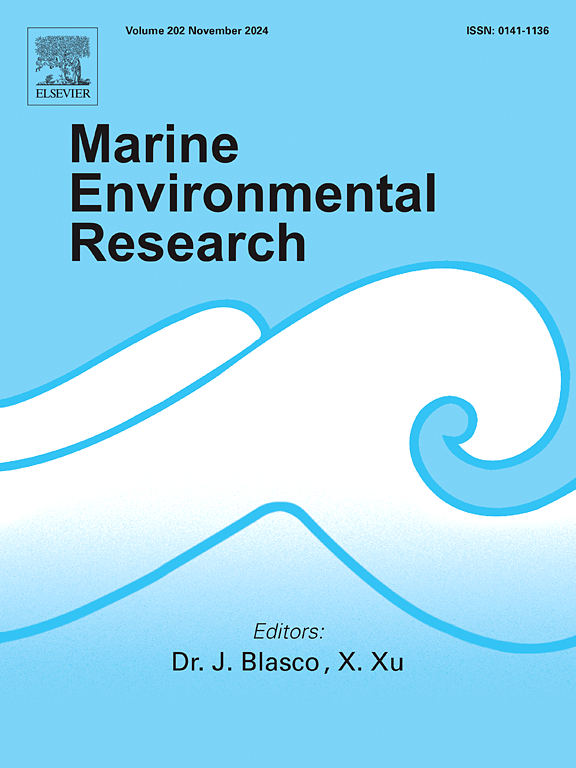Assessing the spatio evolution of carbon sequestration and optimizing ecological restoration strategies using the InVEST model: A case study of the Yellow River Estuary, China
IF 3
3区 环境科学与生态学
Q2 ENVIRONMENTAL SCIENCES
引用次数: 0
Abstract
Coastal wetland ecosystems play a significant role in the global carbon cycle and are among the most effective carbon sinks on Earth. This study focuses on the coastal wetland ecosystem of the Yellow River Estuary, analyzing the spatiotemporal changes in wetland types from 1999 to 2024 using long-term sequential and refined wetland classification data. Furthermore, the study evaluates the dynamic changes in carbon stock through the application of the Integrated Valuation of Ecosystem Services and Tradeoffs (InVEST) model. The results show that: (1) From 1999 to 2024, the area of the shoreland increased by 22.8 %, approximately 99.1 km2, with minimal changes in the area of wetlands such as Phragmites australis, Paddy Fields and Ponds, while the area of wetlands like Intertidal Flats and Suaeda salsa was more significantly affected by the invasion of Spartina alterniflora and the subsequent ecological restoration measures. (2) The spatial distribution of carbon stock exhibited significant heterogeneity, with higher carbon stock in areas along the riverbanks and lower carbon stock in the intertidal areas. Overall, carbon stock showed a trend of "increasing first and then decreasing" with a reduction of 2.46 % by 2024 compared to 1999, amounting to approximately 54,200 tons. (3) The primary factors influencing carbon stock changes include natural processes such as sedimentation and land formation by the Yellow River, as well as human-driven ecological restoration efforts. The continuous decrease in carbon sink areas and increase in carbon source areas have led to the gradual reduction of overall carbon stock. This study constructs a framework for carbon stock assessment and optimization of ecological restoration strategies using the InVEST model, enhances the understanding of how specific wetland ecosystems contribute to the carbon cycle amidst global environmental changes, providing valuable insights for regional sustainable development and ecological conservation.
基于InVEST模型的黄河河口河段固碳空间演化与生态修复优化——以黄河河口为例
沿海湿地生态系统在全球碳循环中发挥着重要作用,是地球上最有效的碳汇之一。以黄河口滨海湿地生态系统为研究对象,利用长期序贯和精细化湿地分类数据,分析1999 - 2024年湿地类型的时空变化特征。应用生态系统服务与权衡综合评价(InVEST)模型对碳储量的动态变化进行了评价。结果表明:①1999 - 2024年,滨地面积增加22.8%,约为99.1 km2,芦苇、水田、池塘等湿地面积变化较小,潮间带、沙豆沙等湿地受互花米草入侵及后续生态恢复措施的影响较为显著;②碳储量的空间分布具有显著的异质性,沿河岸地区碳储量较高,潮间带地区碳储量较低。总体而言,碳储量呈现“先增加后减少”的趋势,到2024年,碳储量比1999年减少2.46%,约为54,200吨。(3)影响碳储量变化的主要因素包括黄河淤积、成陆等自然过程以及人为驱动的生态恢复。碳汇区不断减少,碳源区不断增加,导致总体碳储量逐渐减少。本研究构建了基于InVEST模型的湿地碳储量评估和生态恢复策略优化框架,增强了对全球环境变化中特定湿地生态系统对碳循环的贡献的认识,为区域可持续发展和生态保护提供了有价值的见解。
本文章由计算机程序翻译,如有差异,请以英文原文为准。
求助全文
约1分钟内获得全文
求助全文
来源期刊

Marine environmental research
环境科学-毒理学
CiteScore
5.90
自引率
3.00%
发文量
217
审稿时长
46 days
期刊介绍:
Marine Environmental Research publishes original research papers on chemical, physical, and biological interactions in the oceans and coastal waters. The journal serves as a forum for new information on biology, chemistry, and toxicology and syntheses that advance understanding of marine environmental processes.
Submission of multidisciplinary studies is encouraged. Studies that utilize experimental approaches to clarify the roles of anthropogenic and natural causes of changes in marine ecosystems are especially welcome, as are those studies that represent new developments of a theoretical or conceptual aspect of marine science. All papers published in this journal are reviewed by qualified peers prior to acceptance and publication. Examples of topics considered to be appropriate for the journal include, but are not limited to, the following:
– The extent, persistence, and consequences of change and the recovery from such change in natural marine systems
– The biochemical, physiological, and ecological consequences of contaminants to marine organisms and ecosystems
– The biogeochemistry of naturally occurring and anthropogenic substances
– Models that describe and predict the above processes
– Monitoring studies, to the extent that their results provide new information on functional processes
– Methodological papers describing improved quantitative techniques for the marine sciences.
 求助内容:
求助内容: 应助结果提醒方式:
应助结果提醒方式:


